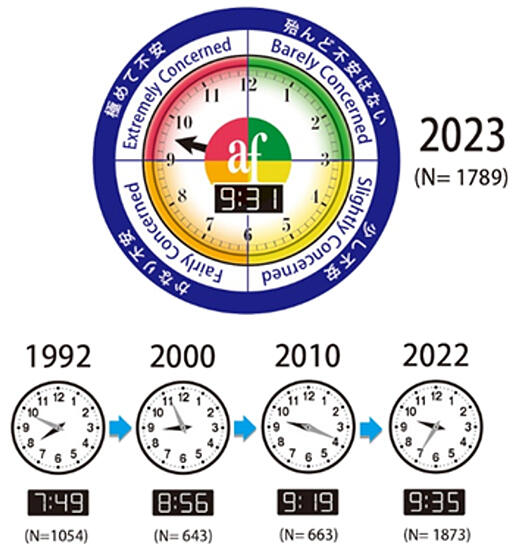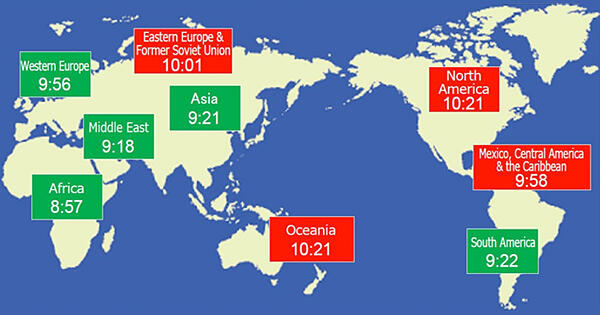As a result of a survey of experts around the world, the Asahi Glass Foundation (Chairman, Takuya Shimamura) announced that the global average time of the 'Environmental Doomsday Clock', which senses the crisis of global environmental problems, is 9:31 this year. Although the hand moved back 4 minutes compared to last year, it surpassed 9 o'clock, the time of 'Extremely Concerned' for the 23rd consecutive year. The time in the environmental field of 'biodiversity' was 9:59, and 'climate change' was 9:33, both indicating the sense of serious crisis.
Each year, the Foundation conducts a survey of experts, government, and non-governmental organizations involved in global environmental issues and indicates the severity as measured by the 12 hours beginning from 00:01. The survey is conducted from April to June every year. The survey this year compiled responses from 1,805 people from 130 countries, including Japan.
Among the nine focused fields, 'Climate Change' (32%) was the most important, followed by 'Biodiversity' (13%), 'Society, Economy and Environment, Policies, Measures' (12%), 'Water Resources' (9%), and 'Pollution/Contamination' (8%). In terms of sector, the clock times of 'Biodiversity' and 'Climate Change' were advanced of the world average time, and those of 'Land Use,' 'Population,' 'Pollution/Contamination,' and 'Water Resources' were behind it. However, the overall trend was past 9:00, suggesting 'Extremely Concerned.'

Provided by the Asahi Glass Foundation
Looking at the sense of crisis over the global areas (weighted average), in 'Eastern Europe and the former Soviet Union,' where Russia continues its invasion of Ukraine, the clock was 10:01, 30 minutes ahead of world average time. The time in Japan was 9:31, the same as the world average time. In terms of time by sector in Japan, the time for 'Climate Change' was 9:29, and the time for 'Biodiversity' was 10:00, both indicating a high sense of crisis.
The survey also asked about 'Signs of Improvement in the Approach to Environment Issues.' As a result, 27% of respondents answered that there were signs for 'Climate Change,' and many people praised the improvements in 'Public Awareness.' However, the rating for 'Policies and Legal Systems' was low.
Among the 17 'Sustainable Development Goals (SDGs),' the level of interest in world issues by the respondents was in the following order: (i) 'Climate Action (No. 13)' > (ii) 'No Poverty (No. 1)' > (iii) 'Peace, Justice and Strong Institutions (No. 16)' > (iv) 'Zero Hunger (No. 2)' > (v) 'Clean Water and Sanitation (No. 6).' Regarding the level of interest in daily life, 'Good Health and Well-being (No. 3)' and 'Affordable and Clean Energy (No. 7)' had high scores, along with as 'Climate Action.'
The Environmental Doomsday Clock has been announced by the Asahi Glass Foundation since 1992. The Clock indicates 'Barely Concerned' from 00:01 to 3:00, 'Slightly Concerned' from 3:01 to 6:00, and 'Fairly Concerned' from 6:01 to 9:00. In 2000, the time was 8:56, but it moved to 9:08 in 2001. Since then, the hands of the clock have kept 'Extremely Concerned' with some fluctuation. The most advanced time of 9:47 occurred in 2018 and 2020. Abnormally high temperatures were reported worldwide in both of these two years, and the same was true for the years before. Record-high temperatures were observed during the summer of 2023 in many parts in the Northern Hemisphere, and the next Environmental Doomsday Clock may reflect the anomaly and move forward again.
In the 32nd survey by the Foundation conducted this year, there was high-level interest in the problem of climate change. Free-text comments indicated the crisis of the impact of climate change and the delay in countermeasures that are becoming increasingly apparent in the world. A Japanese researcher, who is world-famous in environmental engineering, wrote the following answer, 'The droughts, heat waves, wildfires, and floods in the world were induced by unprecedented climate change, and we need to take countermeasures with a sense of future crisis."

Provided by Asahi Glass Foundation
Original article was provided by the Science Portal and has been translated by Science Japan.




